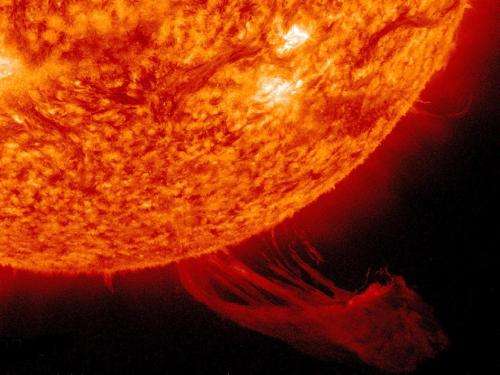Study confirms 'gusty winds' in space turbulence

A research team led by the University of Iowa reports to have directly measured a kind of turbulence that occurs in space plasma for the first time in the laboratory.
Imagine riding in an airplane as the plane is jolted back and forth by gusts of wind that you can't prove exist but are there nonetheless.
Similar turbulence exists in space, and a research team led by the University of Iowa reports to have directly measured it for the first time in the laboratory.
"Turbulence is not restricted to environments here on Earth, but also arises pervasively throughout the solar system and beyond, driving chaotic motions in the ionized gas, or plasma, that fills the universe," says Gregory Howes, assistant professor of physics and astronomy at the UI and lead author of the paper to be published Dec. 17 in the online edition of Physical Review Letters, the journal of the American Physical Society. "It is thought to play a key role in heating the atmosphere of the sun, the solar corona, to temperatures of a million degrees Celsius, nearly a thousand times hotter than the surface of the sun."
He adds: "Turbulence also regulates the formation of the stars throughout the galaxy, determines the radiation emitted from the super massive black hole at the center of our galaxy and mediates the effects that space weather has on the Earth."
One well-known source of gusty space winds are the violent emissions of charged particles from the sun, known as coronal mass ejections. These solar-powered winds can adversely affect satellite communications, air travel and the electric power grid. On the positive side, solar storms also can also lead to mesmerizing auroras at the north and south poles on Earth.
Howes notes that unlike gusts of wind on the surface of the Earth, turbulent motions in space and astrophysical systems are governed by Alfven waves, which are traveling disturbances of the plasma and magnetic field. Nonlinear interactions between Alfven waves traveling up and down the magnetic field—such as two magnetic waves colliding to create a third wave—are a fundamental building block of plasma turbulence, and modern theories of astrophysical turbulence are based on this underlying concept, he says.
"We have presented the first experimental measurement in a laboratory plasma of the nonlinear interaction between counter-propagating Alfven waves, the fundamental building block of astrophysical turbulence," Howes says.
More information: Preprints of the abstract and paper, "Toward Astrophysical Turbulence in the Laboratory," (PDF download) are available at: lanl.arxiv.org/abs/1210.4568
Journal information: Physical Review Letters
Provided by University of Iowa
















